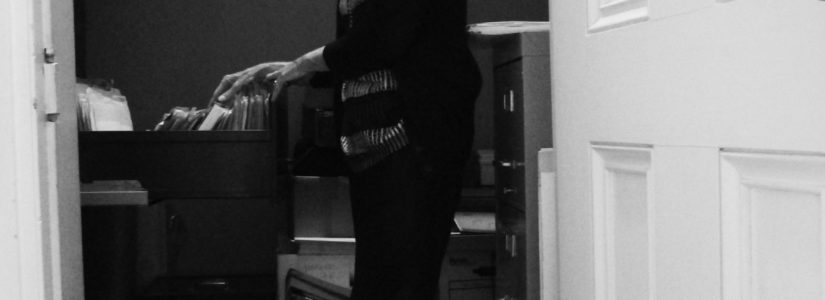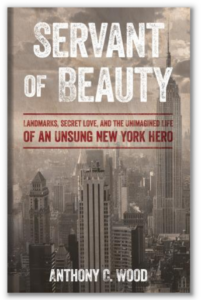
Updates from the Archival Assistance Fund
October 17, 2014
Article from the Fall 2014 Newsletter
It has been a year since the New York Preservation Archive Project awarded grants from its Archival Assistance Fund to worthy archival projects at preservation-related not-for-profits and house museums across New York City. The Archival Assistance Fund, established to help identify and maintain archival resources related to the historic preservation movement, is another example of outreach initiatives on the part of the Archive Project to provide practical assistance to the preservation community. The grantees have made considerable progress over the past year.
The Archival Assistance Fund’s grant to the Morris-Jumel Mansion Museum allowed for the installation of digitally-regulated cooling, heating, and humidity equipment in the spaces where the Museum’s collection is stored. The archival environment has now been stabilized for the first time in the collection’s 100-year history. This equipment has also created a temperature-regulated space in which the archivist can work comfortably throughout the year, increasing productivity in reaching their archival goals. In the past year alone, nearly 200 early-20th-century blueprints have been catalogued and properly stored, the majority of their rare 19th-century book library has been professionally consolidated and preserved, and the Museum’s manuscript collection, including previously unknown documents from colonial era New York, is now housed in a clean flat file that is extensively monitored for humidity and temperature changes. Further, the stabilized environment has allowed the archives to become a more integral resource within the Museum. The archive is now more accessible to educators, the Museum curator, and administrative staff, allowing a more in-depth history of the mansion and Manhattan to be presented to visitors. The Museum continues to develop the archives and library as a research center both for internal personnel and outside scholars.
The Merchant’s House Museum has been able to make great strides in the processing and re-housing of the institutional archives of Museum founder George Chapman (1935-1958), the Decorators Club (1958-1968), and restoration architect Joseph Roberto (1968-1989). Together, these archives—made up of ephemera, architectural drawings, photographs, newspaper clippings, phone logs, guest registers, member rolls, and correspondence—contain more than 50 years of history during the building’s second life as a historic house museum. The collection’s contents tell the story of the transition from home to museum, its struggle to survive during the difficult times of mid-20th-century East Village history, its 1960s designation as a New York City landmark, and its 1970s restoration. The archives are a crucial resource for the study of architecture, design, preservation, and New York City history, as well as the development of historic house museums. Through this project, the Museum has been able to guarantee the long-term preservation of this material while also making it more accessible for research. These materials can now also be safely displayed and used in exhibitions and educational programming. After securing additional funding from the Department of Cultural Affairs, the Museum plans to continue this project and other archival work, including digitizing nearly 5,000 slides from 1978-1991; 2,000 of these images depict the Roberto restoration.
The archival project at FRIENDS of the Upper East Side Historic Districts has also made considerable progress. Archivist William Dean has sorted through dozens of file boxes from the organization’s early years and has created a fully-searchable database of the collection’s contents using Archivists’ Toolkit, an open-source archival data management program. The majority of the material processed during this project relates to the work of FRIENDS from the 1980s to the early 1990s, focusing especially on the creation and expansion of historic districts and general preservation issues on the Upper East Side. There is correspondence with Mayors Dinkins, Koch, and Guiliani, and numerous other well-known New Yorkers, as well as a great deal of internal communication concerning campaigns to rezone sections of the Upper East Side to encourage contextual construction and save historic buildings. FRIENDS plans to digitize some of the documents and photographs, which can then be linked to the database record and made available online. The database will become an important resource for preserving the history of FRIENDS as an organization and making its history more accessible to the public.
The Bartow-Pell Mansion Museum (BPMM) was awarded a grant in support of their International Garden Club Archives Inventory Project. With these funds, BPMM hired archivist Christine Williams to perform a collection survey and inventory, rehouse the collection in archival boxes and folders, and create finding aids. The grant also paid for the purchase of acid-free storage materials. The International Garden Club (IGC) archives (1914-2008) document how a group of early-20th-century preservationists and horticultural enthusiasts restored the Bartow mansion and carriage house; transformed the buildings into an historic house museum; created an important c. 1916 garden; and preserved historically significant portions of the 18th-century Pell family landscape in what is today the Bronx. The collection consists of historic structure reports, membership records, meeting minutes and committee reports, scrapbooks, guest books, photo albums, invitations, newspaper clippings, photographs, bank statements, and correspondence. There are also materials related to programming—including garden competitions, fashion shows, tours, musicals, flower shows, garden parties, teas, and exhibitions—as well as IGC publications such as a journal and a cookbook. Previously these records were not systematically organized and were stored in non-archival boxes and folders. The project helped in determining the scope of the collection and its components, creating an inventory, implementing systematic organization and storage, creating basic finding aids, storing records in archival materials, and improving public access. The IGC, now the Bartow-Pell Conservancy, began its important preservation work in 1914, and this archival project proved to be a fitting celebration of this preservation group’s centennial.
The Greenwich Village Society for Historic Preservation (GVSHP) used its grant from the Archival Assistance Fund to embark upon a project that will provide online access to its archival image collection. GVSHP’s image collection, just one part of its archival holdings, consists of about 300 photographs, prints, slides, and negatives that chronicle the preservation struggles of the Village. This visual trove is complemented by GVSHP’s oral history series, in which community members document their preservation efforts for the Village. After careful research, GVSHP selected the open source web-publishing platform Omeka for their online catalogue. Omeka was developed by the Roy Rosenzweig Center for History and New Media for the display of library, museum, archival, and scholarly collections and exhibitions. One reason this platform was chosen was that it will also accommodate the future cataloging of GVSHP’s oral history collection. This fall, the organization will identify a project manager to ensure that the catalogue maintains a look and feel that is consistent with the current design of the GVSHP website. The Archive Project looks forward to perusing the catalogue of images once it is live!
The great success of this inaugural round of Archival Assistance grants by NYPAP demonstrates that there is a genuine need for this kind of funding. Despite their unique missions and the diversity of their archival holdings, each grant recipient boasts a record of activism in preservation and a demonstrated commitment to safeguarding the story of those preservation efforts. The Archive Project hopes these projects will serve as inspiration to other organizations with archival projects still in need of addressing. To that effect, we are excited to announce that funding has been secured for another round of grants in 2015! Please stay tuned for details in the coming months.




